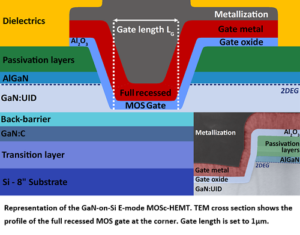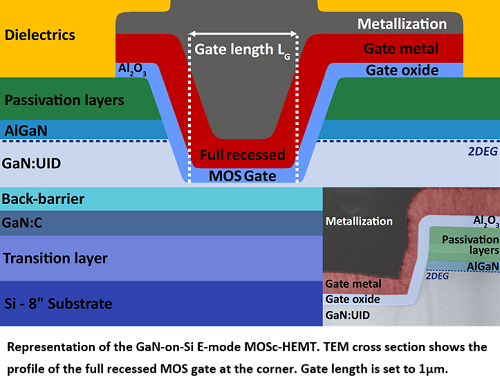
Two complementary research papers from CEA-Leti confirmed that the institute’s approach to gallium-nitride (GaN) technologies is on track overcome challenges in the architecture and performance of advanced GaN devices embedding a MOS gate, and targeting the fast-growing global market for power-conversion systems.
In papers presented at IEDM 2020, scientists recounted experiments with variations of high-electron- mobility transistors (HEMT) based on gallium nitride-on-silicon (GaN-on-Si), called GaN-on-Si HEMT. GaN-based semiconductors improve both performance and reliability of increasingly compact power converters compared to silicon, and AIGaN/GaN HEMTs have shown potential to replace power-conversion solutions based on Si or SiC for high-frequency applications with high power and low noise. This technology is therefore expected to be a cost-effective, power-conversion solution for many end-user applications, ranging from smartphones to kitchen appliances and e-vehicles and from battery loaders to DC/DC or AC/DC converters.

Considered together, the two papers provide a novel understanding of the gate stack of the GaN MOS-c HEMT developed at CEA-Leti in the IRT Nanoelec framework. They demonstrate the complexity of GaN MOS stack characterization as well as the requirement for deep expertise to report and analyze reliable parameter values. The work presented in these papers will also help to solve detrimental effects occurring in GaN devices to improve reliability, which is one of CEA-Leti’s key missions during an industrial transfer.
“Carbon-Related pBTI Degradation Mechanisms in GaN-on-Si E-Mode MOSc-HEMT”
This paper investigated the physics behind positive-Bias Temperature Instability (pBTI) effects that occur when transistor gates are positively biased, to determine the root cause of this effect and to minimize it.
“We showed that the instabilities of voltage threshold (Vth) under positive gate stress were caused by two populations of traps,” said Aby-Gaël Viey, an author of the paper. “The first is related to defects in the gate oxide, which is a known effect, and the second to the presence of carbon atoms in nitrogen sites in GaN at the gate interface, which was a discovery, thus confirming the conclusions presented at IEDM.”
Generally in MOS technology where BTI is a common reliability test, e.g. Si/SiGe/Ge-based CMOS technologies, the root causes of Vth instabilities are related to oxide defects that can be charged or discharged by electrons or holes depending on device type (n/p-MOS) and bias polarity. In the case of GaN MOS-c HEMTs, the epitaxial structure grown underneath the transistor is extremely complex and far from homogeneous.
This study also confirmed the conclusions of the work CEA-Leti reported in an IEDM 2019 paper that showed that carbon in GaN-in-N [CN], which usually is introduced as a deep acceptor to create a semi-insulating GaN layer for breakdown-voltage management, is responsible for a part of the BTI instabilities along with the common oxide traps charging. The epitaxial structure is thus a great concern to reduce and minimize instabilities in GaN power devices.
“In addition, our more recent work demonstrated that it is possible to accurately model and predict these threshold voltage instabilities with great precision,” Viey added. “Indeed, the known model of capture emission time (CET) maps were used to confirm the presence of the two populations of traps and predict pBTI degradation (Vth shift) under a certain gate/temperature stress condition.”
“A Novel Insight on Interface Traps Density (Dit) Extraction in GaN-on-Si MOS-c HEMT”
This study set out to characterize the oxide/GaN interface electrical quality to understand if the interface trap density of CEA-Leti’s gate stack was the main threshold voltage (Vth) contributor in GaN-on-Si MOS-c HEMT, and to confirm the performance of the institute’s solution developed during 10 years of R&D.
Dit extraction extracts the density of interface defects that are electrically active at an oxide/semiconductor interface, as well as its distribution in terms of energy with the bandgap of the semiconductor. It is important because Vth is directly related to physical parameters such as metal-gate work function and doping of the semiconductor, which are easily adjustable, and to some defect-related parameters such as fixed or mobile charges in the oxide and interface state density. This density can dramatically influence Vth if the interface is not correctly passivated and processed.
In the case of GaN MOS-c HEMTs, the GaN is dry-etched before oxide deposition and this aggressive process step can have a tremendous impact on the future oxide/GaN interface. Thus, having an accurate and reliable characterization technique of this interface is a requirement to develop and optimize MOS-based GaN power devices. “For other industries or researchers, this kind of approach would help to assess the interface trap density,” said William Vandendaele, an author of the paper.
Vandendaele said the next steps for CEA-Leti researchers are to expand the teams’ understanding of gate-stack optimization of GaN MOSc HEMTs to minimize Dit values, and to transfer the best product, process and characterization methodology to the institute’s industrial partners in IRT PowerGan.
CEA-Leti will pursue its GaN roadmap with further research on epitaxy, devices, passive components, co-integration, and system architectures to develop a GaN technology that allows switching frequencies in the MHz and power densities 10 times those of silicon — all using standard CMOS processes to keep costs down.
Part of this work has been achieved in the frame of IRT Nanoelec

















